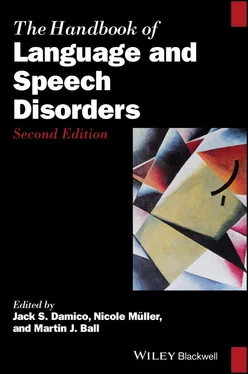While the most obvious harmful consequences may result from errors in labeling, the negative impact of the process is more complex and insidious. It must be remembered that labels are actually summaries of complex symptoms, a “mental shorthand” that plays into the human inclination to stereotype and make generalizations (Leyens et al., 1994). While this propensity does assist in communicating ideas underlying the labels, there is also the tendency to stop looking at the individual and start assuming that he or she is defined by the label and its characteristics. This assumption enables the professional to stereotype the unique aspects of the labeled individual so that all children with the same label are considered similar. This results in a failure to notice and account for personal strengths and difficulties. The consequence is a reduction of individual differences and a limitation on the ways in which the individual is perceived and treated (Lubinski, 2000; Madon et al., 2006).
Another negative consequence of labeling arises from the very practice of assigning a label. If the intent is to label an individual, then often there is an assumption that not only the symptoms, but their origins exist within the individual being labeled. Consequently, there is a predisposition to localize the problems within the individual rather than to search for multiple factors and extraneous variables, including, for example, teaching styles, prior exposure to opportunities to learn and apply the targeted skills, and diversity issues in schoolchildren (Brown, 1995; Coles, 1987; Conrad, 2000; Forness, 1976; McDermott, 1987, 1993; Rapley, 2004). The decision to focus on intrinsic causal factors rather than extrinsic factors (or at least a combination) is likely a primary reason for the overrepresentation of various ethnic and socioeconomic groups in some aspects of special education (e.g., Cummins, 2000; Damico, 1991; Hamayan et al., 2013; Hood, McDermott, & Cole, 1980; McDermott & Varenne, 1995; McNamara, 1998). Treating labels as verification of intrinsic disability may also be based on the assumption that the source of all educational difficulties is related to causes that are intrinsic to students (Carroll, 1997; Gutkin & Nemeth, 1997). This assumption is exacerbated by the general lack of familiarity that the public has with the principles of language and learning in academic and communicative contexts.
Unfortunately, this belief in the primacy of intrinsic causal factors, exacerbated by labeling, frequently results in negative consequences. The label is often used to “explain away” the problem, so that if, for example, a child experiences poor teaching or unresponsive therapy, the propensity is to place blame on the child, not the methods or the teacher/therapist. The within‐child deficit model makes for an easy and effective excuse.
Since most people are not oriented to the complexity of human meaning making and the importance of systems theory when addressing learning and communicative processes (MacWhinney, 1998; Nelson, 2003; Perkins, 2005; Thelen & Smith, 1998; van Geert, 1998), they are often willing to localize problems in the individual; it is simply easier to do so. To ignore the complexity is often soothing even if it is misdirected. The problem with using the label to reduce the complexity, of course, is that poor results ensue. Even if teachers or rehabilitative professionals are dedicated to the remediation process, their best attempts at assistance often are misguided and ineffective. In fact, research has documented that labeling with a focus on an intrinsic deficit model typically results in overlooking various environmental factors that may have generated or exacerbated the difficulty (Barsky & Boros, 1995; Boxer, Challen, & McCarthy, 1991; Brown, 1995; Coles, 1987; Dudley‐Marling & Dippo, 1995). As Brechin (1999) discussed, “If the whole problem, by definition , lies with the individual [via a label], then our understandings and interventions start and stop with the individual” (p. 1, original emphasis).
Labeling as a process is often discussed within the sociological literature and it is frequently linked with assessment. This is due to the fact that most test development was designed for selection purposes (Glaser & Silver, 1994), that is, to determine who should be admitted to and benefit from what educational opportunity (Carroll, 1997; Damico, 2019; Glaser & Silver, 1994; Lohman, 1997). To create divisions for selection, however, a label must be supplied. Consequently, labels often become the handmaidens of societal biases and prejudices. Within this function, labeling has particularly damaging consequences. Assessment and the resultant labels assigned to many students are often used to create a kind of social stratification system, a way to keep people in their place (Artiles, Higareda, Rueda, & Salazar, 2005; Bradley & Corwyn, 2002; Cummins, 2000; Ogbu & Simons, 1998; Ruiz‐de‐Velasco & Fix, 2000). This labeling process and its resultant placements are a reflection of how power and control is exerted in assessment to fulfill societal roles of cultural and social reproduction (Abberley, 1987; Apple, 1982; Kavale & Forness, 1998; Loseke, 1999). The assignment of a label and the various consequences play a key role in cultural reproduction and social stratification (Gipps, 1999). In his discussion of the impact of assessment and labeling theory in education in the United Kingdom, Broadfoot (1996) stated,
… because assessment procedures are so closely bound up with the legitimization of particular educational practices, because they are the overt means of communication from schools to society and … the covert means of that society’s response in the form of control, assessment may be the most important of the three message systems. Assessment procedures may well be the system that determines curriculum and pedagogy and, hence, social reproduction. (p. 87–88)
Within the realm of special education, labeling students and placing them in remedial programs—even if only for a half an hour a day—effectively removes these students from general schooling and places them in groups of students of similar ability for instructional purposes; they are socially isolated (Connor & Ferri, 2005; Fine, 1991; Gelb & Mizokawa, 1986; Gill & Maynard, 1995; Messick, 1980).
Social isolation and stratification often prevent access to equal educational and occupational opportunity. Research in literacy employing a critical interpretivist frame, for example, has found that attaching labels like “intellectually disabled,” “mentally retarded” and “dyslexic” significantly reduces the expectations and opportunities for individuals to become literate or to use their literacy skills to improve with practice (Kliewer, Biklen, & Kasa‐Hendrickson, 2006). Similarly, Rapley (2004), employing discursive psychology, explored the actual process of limiting opportunity for those individuals labeled “intellectually disabled” through moment‐by‐moment interaction with care staff and other professionals. This tendency to limit access due to expectations formed by labels is one of the most damaging consequences of this diagnostic process. In education, those professionals who both assign the labels through assessment, and then help prevent access through various means (special education placement, tracking, limiting extracurricular activities) are known as “gatekeepers” (Deyhle, 1987; Mehan, Hertwick, & Meihls, 1986; Ogbu, 1978; Schuster & Butler, 1986; Thoits, 2005). The term is uncomfortably accurate in many instances.
Finally, labels can have negative consequences for one’s psychological health and self‐image . While there are many instances of labeling helping to define individuals and letting them develop a workable self‐image based upon identification with a disability label (see Section 1.2), an opposite reaction can also occur. Research in “labeling theory” (Heise, 2007; Kroska & Harkness, 2008; Link et al., 1989; Rosenfeld, 1997) demonstrates that when individuals are labeled, the societal and cultural ideas associated with the disability in general and the label in particular become personally relevant to that individual and often foster negative self‐feeling. These feelings can have a profound impact on the labeled individual.
Читать дальше












